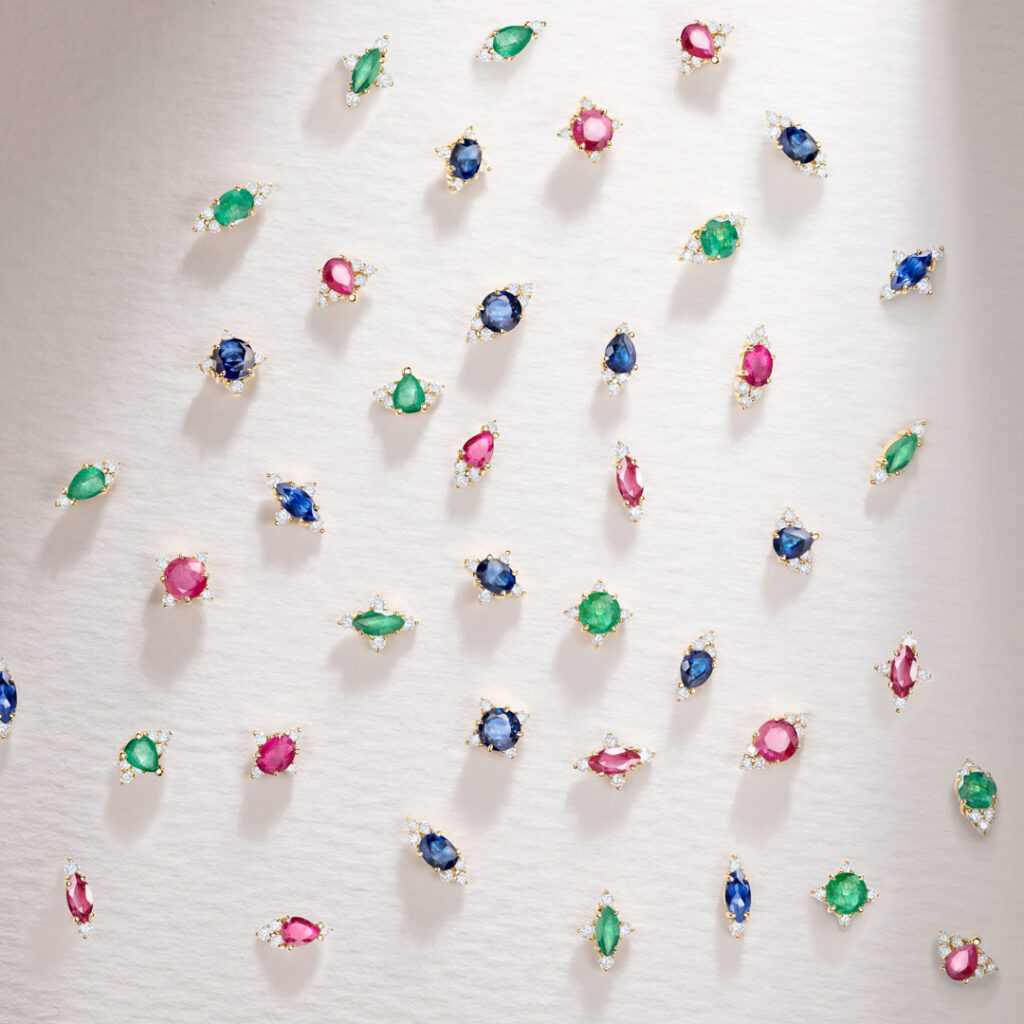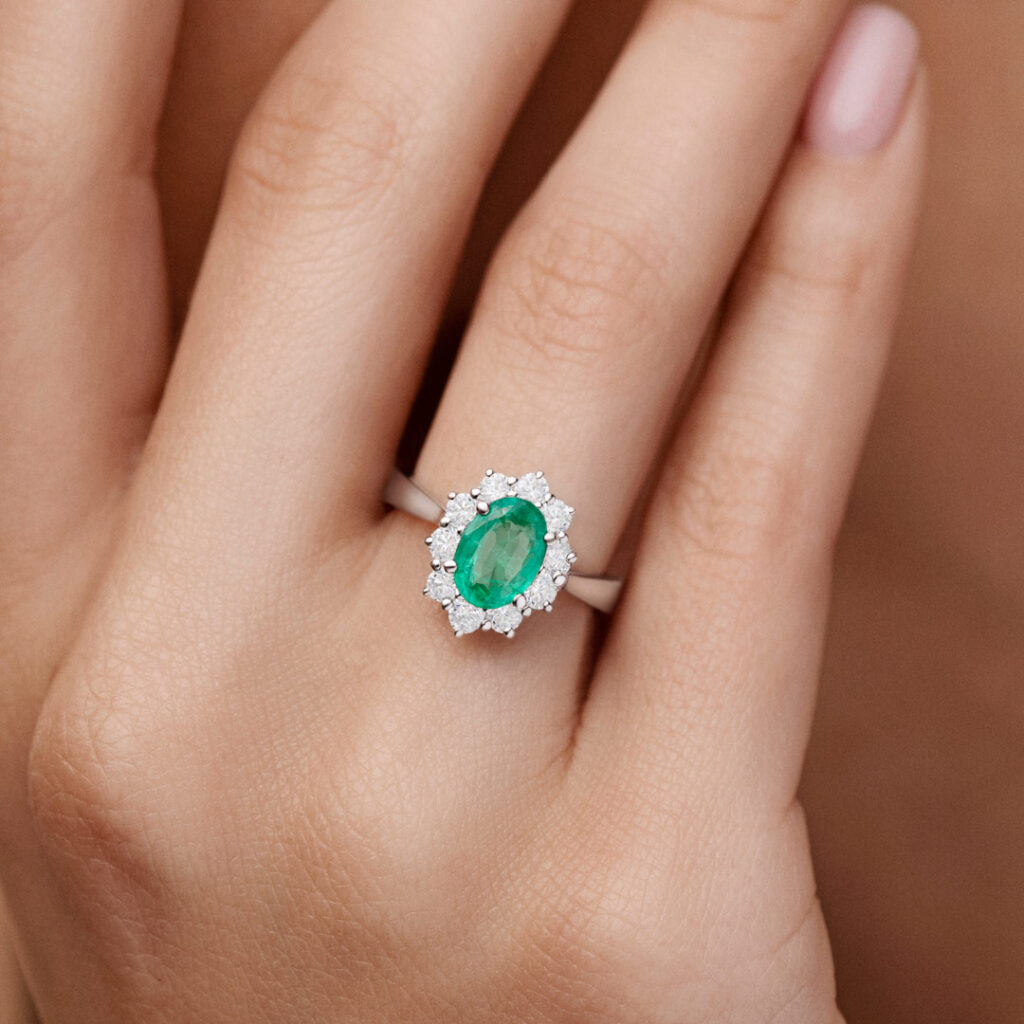If you are interested in gemology and fine jewelry, you surely know what precious gemstones are. Hypnotic and dazzling, they have captivated the human imagination for millennia. As part of the most valuable jewelry collections, they are also capable of capturing and conveying unique stories.
In Mumit’s online jewelry store, you can discover the different personalities of each gemstone and the extraordinary way they transform every design. The brand’s gemstone jewelry is conceived to enhance the beauty of the starring gems, carefully selected by their expert gemologists.
If, after admiring these exquisite 18k gold jewelry pieces, you also wonder how golds is formed and how gemstones are created, in today’s article, you will uncover the details of this fascinating process: from the crystallisation of minerals to the characteristics of gemstone inclusions.

What is the process of gemstone formation?
Precious gemstones share a common characteristic: their formation process occurs under extreme pressure and high temperatures within the Earth’s interior. Thanks to various scientific methods and advances in the field of geology, we have learned that it can take millions of years for the creation process to come to fruition.
As you know, gemstones exhibit unique physical characteristics and appear in specific geological environments. Here are some of the most notable ones.
Igneous Rocks
This type of rock results from the cooling of magma from the Earth’s depths. The most well-known gemstone found in igneous rocks is the diamond. Created from carbon deposits subjected to extremely high pressure, it is later brought to the surface during volcanic eruptions. Isn’t it fascinating to think that this is the origin of our favourite diamond jewelry?
Metamorphic Rocks
Metamorphic rocks are formed from pre-existing rocks within the Earth. Sapphires and rubies are some of the gems that can arise from these environments if they are rich in aluminium and subjected to high pressure and temperatures.
Their colour depends on the traces of minerals present during the formation process. Likewise, sapphire jewelry and ruby jewelry will exhibit completely unique characteristics as a direct consequence of this fascinating formation process.
We want to highlight tanzanites, a special gem found only in the metamorphic rocks on the slopes of Mount Kilimanjaro in Tanzania. Their hypnotic blue to violet colour varies depending on the light and angle from which it is viewed.

If you want to observe the unique beauty of this natural wonder, we recommend Mumit’s Kilimanjaro Rose Tanzanite and Diamond Ring in 18k White Gold. Thanks to the halo of diamonds that surrounds it, our designers have managed to highlight the unique tones of the starring gem, creating a true spectacle of light and colour that will not leave anyone indifferent.
Sedimentary Rocks
This is the least common environment, but some emeralds are created in sedimentary rocks. This happens due to the filtration of water with traces of beryllium into the porous surface of these rocks. Depending on other environmental factors like pressure and temperature levels, they can crystallise to form emeralds. If you want to see the final result of this process for yourself, we invite you to discover the charm of this gem in Mumit’s emerald jewelry.
How do minerals crystallise?
The crystallisation of minerals in the Earth to form gemstones is a crucial part of the process. As mentioned at the beginning of the article, given the right conditions of pressure, temperature, and time, certain combinations of minerals crystallise and result in precious gemstones.
At high enough temperatures, minerals remain in suspension. However, when temperatures drop, the crystallisation process begins. It is important to note that different minerals crystallise at different temperatures. For example, ruby and sapphire typically crystallise first, while quartz will do so much later.
Additionally, the environment needs to maintain high pressure long enough for the minerals to crystallise. Finally, they need sufficient space to grow.
In the case of diamonds, once carbon solutions start to cool, crystallisation occurs, eventually resulting in dazzling diamonds. If you want to add this wonderful symbol of nature’s power to your jewelry collection, how about Mumit’s Diamond Waterfall Necklace in 18k Rose Gold?

We love the contrast of rose gold with the diaphanous sparkle of the diamonds. Moreover, its design is a perfect fusion of modernity and minimalism, making it the perfect piece for the most elegant occasions.
Gemstone Inclusions
Inclusions are a feature that distinguishes natural gemstones from artificial ones. They consist of other mineral substances, liquids, or gases trapped within the gems during their growth process.
Depending on the case, some inclusions are considered an added value, enhancing the beauty of the gemstone. Emeralds are a perfect example since their “internal garden” of inclusions can considerably elevate their value.
If you are looking for gemstone rings for a special occasion and want to witness the beauty of a natural emerald, we believe Mumit’s Irem 0.70 ct Diamond and Emerald Ring in 18k White Gold would be a sublime choice.

Created to become a standout piece, it is an ode to the unparalleled charm of emeralds. Every element of its design has been meticulously conceived to highlight the splendour of this gem and all its unique characteristics.
After analysing all the details about the process of gemstone formation, it is evident that we are dealing with true wonders of nature. As the centrepieces of our favourite jewelry, their beauty was already unquestionable. Now, we have also learned that their mere existence is a testament to the fascinating processes that occur deep within the Earth—a precious relic we can admire daily.
Today, we explored a fundamentally technical aspect of gemology, but if you are interested in learning more about the symbolic value of precious gemstones, we invite you to visit our blog. There, you will find topics as interesting as what stone to choose for an engagement ring, the most famous sapphires in the world, or the difference between an emerald and a diamond.
Additionally, we recommend following Mumit on Instagram so you do not miss any of their new designs featuring the most dazzling precious stones, like their gemstone charms or their gemstone engagement rings.